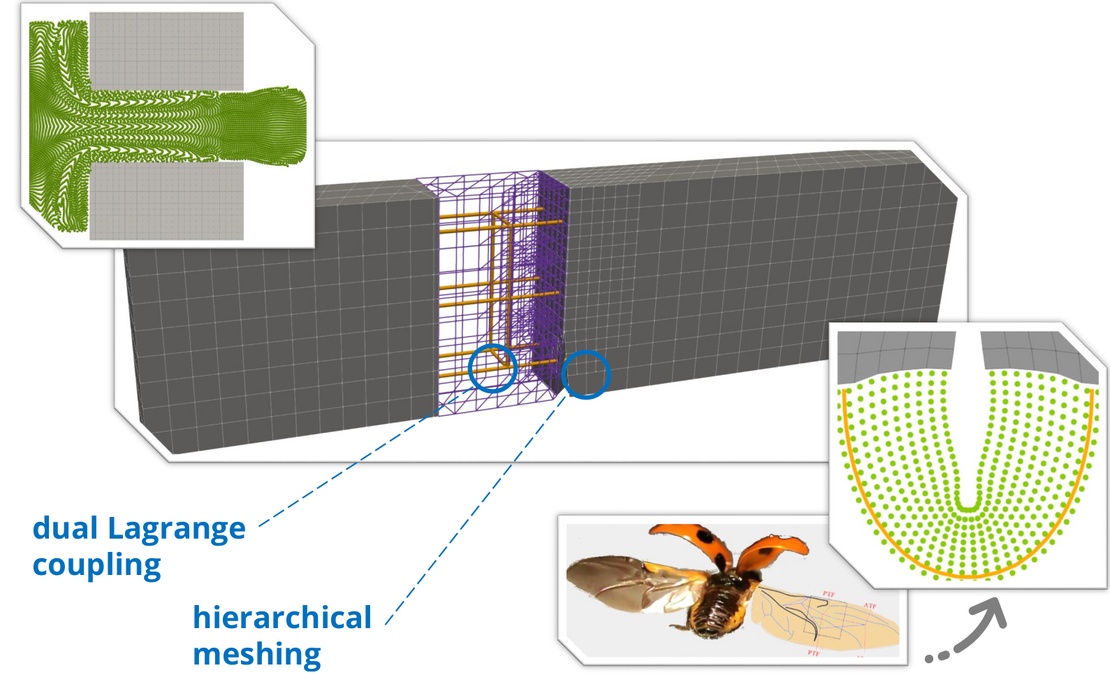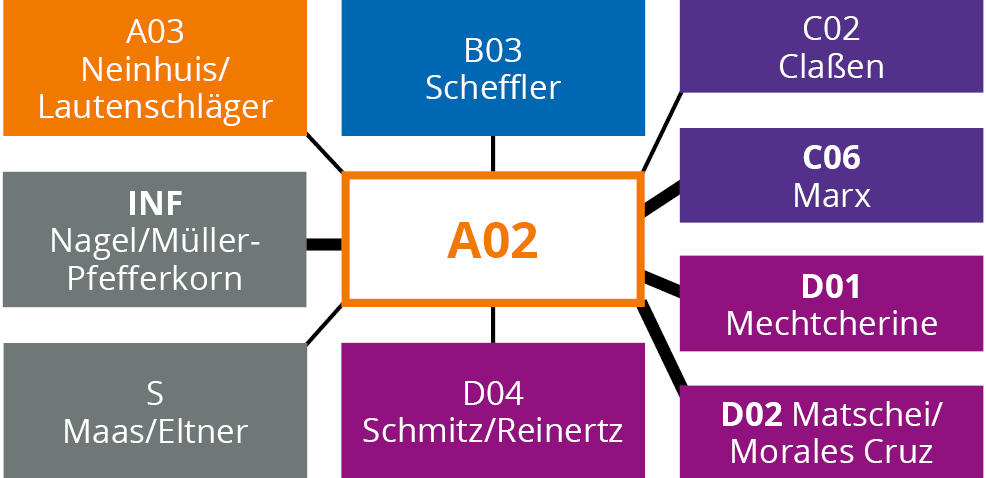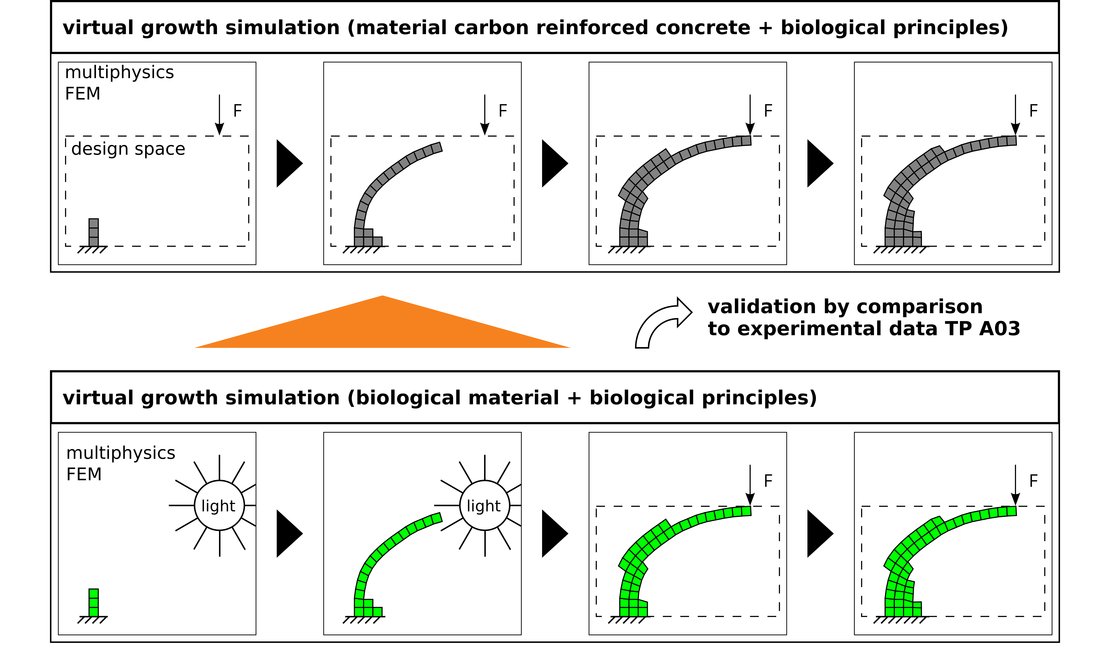Biology inspired modeling of manufacturing processes | Funding Period 2
In the second funding period, numerical models for the simulation and calculation of manufacturing processes for carbon-reinforced concrete components will be developed. The models are based on thermodynamically consistent formulations based on continuum mechanics. These models will take into account phase transformation processes during curing, relative movements between reinforcement elements and concrete, as well as chemically induced prestressing.
Drawing from the adaptation of biological examples, the simulation model will then be used to make predictions for the manufacturing processes pursued in the TRR 280, thereby contributing to their further development.

Scientists
![Prof. Dr.-Ing. habil. Michael Kaliske [Translate to English:] Prof. Dr.-Ing. habil. Michael Kaliske](/fileadmin/_processed_/9/c/csm_A_Kaliske_Quadratisch_376a744898.jpg)
D-01062 Dresden (Germany)
![Dr.-Ing. Johannes Storm [Translate to English:]](/fileadmin/_processed_/4/8/csm_A02_Storm-phase2_849efa8abc.jpg)
01062 Dresden (Germany)
Cooperations

Ehemalige | Former involved
Jakob Platen (research associate, TU Dresden, 10/2020 – 06/2024)
Theoretical-Numerical Mapping of Biological Evolutionary Processes as Structure-Generator for the Design of Load-Carrying Carbon-Reinforced Concrete Structures | Funding Period 2
Project A02 deals with the thermodynamical consistent description of growth processes in biological tissues and the usage of these principles for the design of carbon-reinforced concrete structures. Therefore, biological principles need to be identified und mathematically formulated. The continuummechanical description is done for an implementation in a numerical algorithm. To assure thermodynamical consistency, the balance laws need to be modified. The next step is to validate the derived growth models. For this purpose biological growth processes are numerically simulated. This is done to assure that only assumptions are used which represent reality. Based upon these findings, analogies for the design of carbon-reinforced concrete structures will be derived. The findings will be integrated into a structural generator. The generator will yield optimized structural designs, which will be used as an inspiration in other projects.

Publikationen | Publications
Curosu, V.; Kikis, G.; Krüger, C.; Liebold, F.; Macek, D.; Mester, L.; Platen, J.; Ritzert, S.; Stüttgen, S.; Kaliske, M.; Klinkel, S.; Loehnert, S.; Maas, H.-G.; Reese, S.; Robertz, D. (2023) Ansätze für numerische Methoden zur Inspiration, Analyse und Bewertung neuartiger Carbonbetonstrukturen in: Bauingenieur 98, issue 11, p. 368–377 – DOI: 10.37544/0005-6650-2023-11-56
Platen, J.; Fleischhauer, R.; Kaliske, M. (2023) On the continuum mechanics of growing plant-like structures in: Computational Mechanics, issue 73 – DOI: https://doi.org/10.1007/s00466-023-02387-8
Platen, J.; Pauls, B.; Rjosk, A.; Lautenschläger, T.; Neinhuis, Chr.; Kaliske, M. (2023) Modeling Growth of Plants for Biologically Inspired Structures of Carbon Fiber Reinforced Concrete in: Ilki, A.; Çavunt, D.; Çavunt, Y. S. [eds.] Building for the Future: Durable, Sustainable, Resilient – Proc. of fib Symposium 2023, 05.–07.06.2023 in Istanbul (Turkey), publ. in: Lecture Notes in Civil Engineering 350, Cham: Springer, p. 1262–1272 – https://doi.org/10.1007/978-3-031-32511-3_129
Platen, J.; Storm, J.; Bosbach, S.; Claßen, M.; Kaliske, M. (2024) The microlayer model: A novel analytical homogenisation scheme for materials with rigid particles and deformable matrix matrix – applied to simulate concrete in: Computers & Structures 293, 107258 – DOI: https://doi.org/10.1016/j.compstruc.2023.107258
Platen, J.; Zreid, I.; Kaliske, M. (2023) A nonlocal microplane approach to model textile reinforced concrete at finite deformations in: International Journal of Solids and Structures 267, 112151 – DOI: https://doi.org/10.1016/j.ijsolstr.2023.112151
Stöcker, J.; Platen, J.; Kaliske, M. (2023) Introduction of a recurrent neural network constitutive description within an implicit gradient enhanced damage framework in: Computers & Structures 289, 107162 – DOI: https://doi.org/10.1016/j.compstruc.2023.107162
Vakaliuk, I.; Platen, J.; Klempt, V.; Scheerer, S.; Curbach, M.; Kaliske, M.; Löhnert, S. (2022) Development of load-bearing shell-type TRC structures – initial numerical analysis in: Stokkeland, S.; Braarud, H. C. [eds.] Concrete Innovation for Sustainability – Proc. for the 6th fib International Congress 2022, 12.–16.06.2022 in Oslo (Norway), Oslo: Novus Press, p. 1799–1808.
Vorträge und Poster | Oral presentations and posters
Pauls, B.; Platen, J.; Kaliske, M.; Lautenschläger, T.; Neinhuis, C. (2023) Plant Growth as Inspiration for Novel Carbon Concrete Components poster at: 10. Bionik-Kongress, 12./13.05.2023 in Bremen.
Platen, J.; Kaliske, M. (2022) A Microplane Model for Textile Reinforced Concrete at Finite Stains oral presentation at: 8th European Congress in Computational Methods in Applied Sciences and Engineering, 05.–09.06.2022 in Oslo (Norway).
Platen, J.; Kaliske, M. (2022) Ein kontinuumsmechanisches Modell für das Wachstum von Pflanzen oral presentation at: Baustatik – Baupraxis Forschungskolloquium 2021 in 2022, 27.–30.09.2022 in Kloster Steinfeld.
Studentische Arbeiten | Student's works
Velasquez, S. G. (2021) Elasto-plastic Modelling of Fiber Reinforced Composite Materials at Finite Deformations [Projektarbeit | project work]
Oropeza, A. (2023) Implementation of a Microplane Material Model in the Implicit Material Point Method (MPM) [Projektarbeit | project work]
Oropeza, A. (2023) Implementation of an Implicit Gradient Enhanced Microplane Material Model in the Implicit Material Point Method (MPM) [Masterarbeit | Master’s Thesis]



